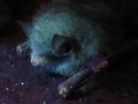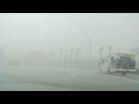(Press-News.org) Scientists working to understand the devastating bat disease known as white-nose syndrome (WNS) now have a new, non-lethal tool to identify bats with WNS lesions —ultraviolet, or UV, light.
If long-wave UV light is directed at the wings of bats with white-nose syndrome, it produces a distinctive orange-yellow fluorescence. This orange-yellow glow corresponds directly with microscopic skin lesions that are the current "gold standard" for diagnosing white-nose syndrome in bats.
"When we first saw this fluorescence of a bat wing in a cave, we knew we were on to something," said Greg Turner from Pennsylvania Game Commission, who has been using this technique since 2010. "It was difficult to have to euthanize bats to diagnose WNS when the disease itself was killing so many. This was a way to get a good indication of which bats were infected and take a small biopsy for testing rather than sacrifice the whole bat."
Millions of bats in the United States have died from the fungal disease called White nose syndrome which is caused by the fungus Pseudogymnoascus (Geomyces) destructans. White-nose syndrome was first seen in New York during the winter of 2006. Since then, the disease has spread to 25 U.S. states and 5 Canadian provinces.
A significant problem in studying WNS has been the unreliability of visual onsite inspection when checking for WNS in bats during hibernation; the only way to confirm presence of disease was to euthanize the bats and send them back to a laboratory for testing.
"Ultraviolet light was first used in 1925 to look for ringworm fungal infections in humans," said Carol Meteyer, USGS scientist and one of the lead authors on the paper. "The fact that this technique could be transferred to bats and have such remarkable precision for indicating lesions positive for WNS invasion is very exciting."
To test the UV light's effectiveness, bats with and without white-nose syndrome in North America were tested by the U.S. Geological Survey's National Wildlife Health Center, first using UV light, then using traditional histological techniques to verify the UV light's accuracy.
In the USGS lab testing, 98.8 percent of bats with the orange-yellow fluorescence tested positive for white-nose syndrome, whereas 100 percent of those that did not fluoresce tested negative for the disease. Targeted biopsies showed that pinpoint areas of fluorescence coincided with the microscopic wing lesions that are characteristic for WNS.
Researchers in the Czech Republic then tested the UV light-assisted biopsy technique in the field, using it to collect small samples from areas of bat wing that fluoresced under UV light. In this study, 95.5 percent of wing biopsies that targeted areas of fluorescence were positive for WNS lesions, while again 100 percent of bats that did not fluoresce were negative for WNS.
Combining research from two continents demonstrates that UV diagnostics might be applicable worldwide with great sensitivity and specificity in detecting WNS.
"Moreover, the technique hurts the animal minimally and bats fly away after providing data for research," said Natalia Martinkova from the Academy of Sciences of the Czech Republic. "This makes UV fluorescence an ideal tool for studying endangered species."
INFORMATION:
This effort included partners in the USFWS, state and federal biologists, the Czech Science Foundation, and the National Speleological Society of the USA.
This research article, "Nonlethal Screening of Bat-wing Skin with the Use of Ultraviolet Fluorescence to Detect Lesions Indicative of White-Nose Syndrome," was recently published in the Journal of Wildlife Diseases. More information may be found on USGS research on white-nose syndrome .
Glow-in-the-dark tool lets scientists find diseased bats
Scientists discover a non-destructive yet effective way to screen bats in hibernation for white-nose syndrome
2014-05-29
ELSE PRESS RELEASES FROM THIS DATE:
Police reform law underenforced by Department of Justice
2014-05-29
CHAMPAIGN, Ill. — A law designed to combat police misconduct is hamstrung by limited resources, a lack of transparency and "political spillover" at the U.S. Department of Justice, says a recently published empirical study by Stephen Rushin, a law professor at the University of Illinois and expert in criminal law and policing.
In 1994, Congress passed 42 U.S.C. Section 14141 as part of the Violent Crime Control and Law Enforcement Act, granting the U.S. attorney general the power to initiate structural reform litigation against local police departments engaged in a pattern ...
Powerful tool combs family genomes to find shared variations causing disease
2014-05-29
(SALT LAKE CITY)—Scientists at the University of Utah (U of U), the University of Texas MD Anderson Cancer Center in Houston and colleagues have developed a powerful tool called pVAAST that combines linkage analysis with case control association to help researchers and clinicians identify disease-causing mutations in families faster and more precisely than ever before.
In a study in Nature Biotechnology, the researchers describe cases in which pVAAST (the pedigree Variant Annotation, Analysis and Search Tool) identified mutations in two families with separate diseases ...
Ecosystem services: Looking forward to mid-century
2014-05-29
(Santa Barbara, Calif.) — As population grows, society needs more — more energy, more food, more paper, more housing, more of nearly everything. Meeting those needs can lead to changes in how land is used.
Native grasslands, forests and wetlands may be converted into croplands, tree plantations, residential areas and commercial developments. Those conversions can, in turn, diminish the health of natural ecosystems and their ability to provide an array of valuable services, such as clean air and water, wildlife and opportunities for recreation, to name a few.
In two ...
Study: Baltimore hookah bars contain elevated levels of carbon monoxide and air nicotine
2014-05-29
Smoking waterpipes, or hookahs, creates hazardous concentrations of indoor air pollution and poses increased risk from diminished air quality for both employees and patrons of waterpipe bars, according to a new study from the Institute for Global Tobacco Control at the Johns Hopkins Bloomberg School of Public Health. In an analysis of air quality in seven Baltimore waterpipe bars, researchers found that airborne particulate matter and carbon monoxide exceeded concentrations previously measured in public places that allowed cigarette smoking and that air nicotine was markedly ...
Solar panel manufacturing is greener in Europe than China, study says
2014-05-29
Solar panels made in China have a higher overall carbon footprint and are likely to use substantially more energy during manufacturing than those made in Europe, said a new study from Northwestern University and the U.S. Department of Energy's Argonne National Laboratory. The report compared energy and greenhouse gas emissions that go into the manufacturing process of solar panels in Europe and China.
"We estimated that a solar panel's carbon footprint is about twice as high when made in China and used in Europe, compared to those locally made and used in Europe," said ...
Study links unexpected death of a loved one with onset of psychiatric disorders
2014-05-29
May 29, 2014 -- The sudden loss of a loved one can trigger a variety of psychiatric disorders in people with no history of mental illness, according to researchers at Columbia University's Mailman School of Public Health and colleagues at Columbia's School of Social Work and Harvard Medical School. While previous studies have suggested there is a link between sudden bereavement and an onset of common psychiatric disorders, this is the first study to show the association of acute bereavement and mania in a large population sample. Findings are published online in the American ...
Domestication of dogs may explain mammoth kill sites and success of early modern humans
2014-05-29
A new analysis of European archaeological sites containing large numbers of dead mammoths and dwellings built with mammoth bones has led Penn State Professor Emerita Pat Shipman to formulate a new interpretation of how these sites were formed. She suggests that their abrupt appearance may have been due to early modern humans working with the earliest domestic dogs to kill the now-extinct mammoth -- a now-extinct animal distantly related to the modern-day elephant. Shipman's analysis also provides a way to test the predictions of her new hypothesis. Advance publication of ...
NASA widens 2014 hurricane research mission
2014-05-29
VIDEO:
During this year's Atlantic hurricane season, NASA is redoubling its efforts to probe the inner workings of hurricanes and tropical storms with two unmanned Global Hawk aircraft flying over storms...
Click here for more information.
During this year's Atlantic hurricane season, NASA is redoubling its efforts to probe the inner workings of hurricanes and tropical storms with two unmanned Global Hawk aircraft flying over storms and two new space-based missions.
NASA's ...
Mechanisms of ibrutinib resistance identified in chronic lymphocytic leukemia
2014-05-29
COLUMBUS, Ohio – A new study has discovered how resistance develops in patients taking ibrutinib, a new and highly effective drug for the treatment of chronic lymphocytic leukemia (CLL).
The study was published in the New England Journal of Medicine and led by researchers at The Ohio State University Comprehensive Cancer Center – Arthur G. James Cancer Hospital and Richard J. Solove Research Institute (OSUCCC – James). It identifies gene mutations that cause ibrutinib resistance in CLL patients.
"Knowledge of these mutations is the first step in the development of ...
New tools help protect world's threatened species
2014-05-29
Athens, Ga. – New tools to collect and share information could help stem the loss of the world's threatened species, according to a paper published today in the journal Science. The study—by an international team of scientists that included John L. Gittleman, dean of the University of Georgia Odum School of Ecology—was led by Stuart L. Pimm of Duke University and Clinton N. Jenkins of the Instituto de Pesquisas Ecológicas in Brazil.
"As databases coalesce and policymakers have access to greater information, we see real and improving successes for conservation science," ...
LAST 30 PRESS RELEASES:
How the parasite that ‘gave up sex’ found more hosts – and why its victory won’t last
When is it time to jump? The boiling frog problem of AI use in physics education
Twitter data reveals partisan divide in understanding why pollen season's getting worse
AI is quick but risky for updating old software
Revolutionizing biosecurity: new multi-omics framework to transform invasive species management
From ancient herb to modern medicine: new review unveils the multi-targeted healing potential of Borago officinalis
Building a global scientific community: Biological Diversity Journal announces dual recruitment of Editorial Board and Youth Editorial Board members
Microbes that break down antibiotics help protect ecosystems under drug pollution
Smart biochar that remembers pollutants offers a new way to clean water and recycle biomass
Rice genes matter more than domestication in shaping plant microbiomes
Ticking time bomb: Some farmers report as many as 70 tick encounters over a 6-month period
Turning garden and crop waste into plastics
Scientists discover ‘platypus galaxies’ in the early universe
Seeing thyroid cancer in a new light: when AI meets label-free imaging in the operating room
Neutrophil-to-lymphocyte ratio may aid risk stratification in depressive disorder
2026 Seismological Society of America Annual Meeting
AI-powered ECG analysis offers promising path for early detection of chronic obstructive pulmonary disease, says Mount Sinai researchers
GIMM uncovers flaws in lab-grown heart cells and paves the way for improved treatments
Cracking the evolutionary code of sleep
Medications could help the aging brain cope with surgery, memory impairment
Back pain linked to worse sleep years later in men over 65, according to study
CDC urges ‘shared decision-making’ on some childhood vaccines; many unclear about what that means
New research finds that an ‘equal treatment’ approach to economic opportunity advertising can backfire
Researchers create shape-shifting, self-navigating microparticles
Science army mobilizes to map US soil microbiome
Researchers develop new tools to turn grain crops into biosensors
Do supervised consumption sites bring increased crime? Study suggests that’s a myth
New mass spec innovation could transform research
Maternal nativity, race, and ethnicity and infant mortality in the US
Migration-related trauma among asylum seekers exposed to the migrant protection protocols
[Press-News.org] Glow-in-the-dark tool lets scientists find diseased batsScientists discover a non-destructive yet effective way to screen bats in hibernation for white-nose syndrome






